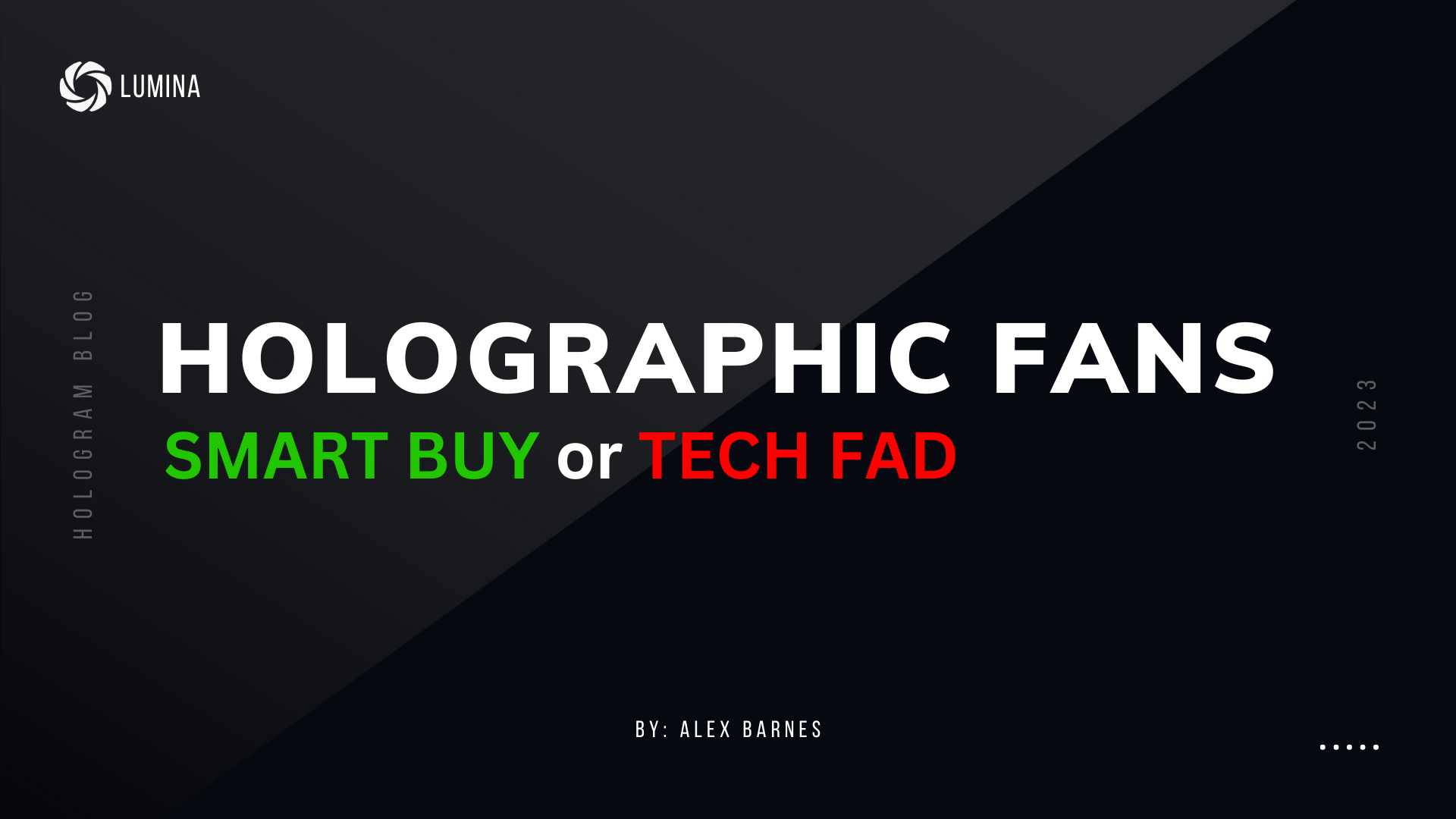In today's evolving retail advertising world, standing out is more important than ever. With many brands battling for consumer attention, unique and innovative advertising strategies are crucial to make a lasting impression.
This article delves into the world of retail advertising, exploring five groundbreaking methods that are transforming the way brands engage with their customers.
Join us as we explore these exciting innovations and how they can elevate your retail advertising strategies to new heights.
1. Holographic Fans: A Revolution in Retail Advertising
The Allure of Holographic Displays
Imagine a retail environment where striking, three-dimensional images float in the air, creating an immersive shopping experience.

Holographic fans make this possible, offering a novel way to capture customer attention and bring products to life.
Understanding the Technology
At the heart of these holographic displays is advanced technology that uses rapid LED rotations to project high-definition 3D visuals. This innovation goes beyond traditional displays, creating an engaging experience that draws in customers and leaves a lasting impression.
Effortless Content Management
Modern holographic fans are designed with ease of use in mind, often featuring mobile app integration for seamless content management. This allows retailers to quickly update their 3D displays, keeping their advertising fresh and relevant to current campaigns and promotions.
Case Studies: Real-World Impact in Retail Spaces
Santa Maria Seasonings Campaign
In a campaign at Bilka hypermarkets and Kvickly supermarkets in Denmark, Santa Maria used holographic displays to showcase new spice container designs. This innovative approach resulted in a 13% increase in sales.
Cloetta's Nutisal Brand Promotion
Swedish company Cloetta ran a holographic display campaign for their Nutisal brand of premium nuts, resulting in a 65% increase in unit sales. This campaign significantly enhanced brand awareness and visibility.
SuperBrugsen's Wine Promotion
SuperBrugsen, a premium supermarket chain, promoted a high-quality red wine using a holographic display in Copenhagen. This approach led to a sixfold increase in wine sales, emphasizing the display's effectiveness.
KIMs Chips Campaign
KIMs' campaign for their new types of chips using holographic displays in Danish Bilka hypermarkets saw a 25% to 100% increase in sales, showcasing the technology's power in product promotion.
2. Interactive Displays in Retail Advertising
Interactive displays are revolutionizing the way customers engage with retail spaces. These innovative solutions range from touchscreen kiosks to interactive mirrors and augmented reality fitting rooms.
They not only provide a dynamic way for customers to explore products but also create memorable shopping experiences.
Types of Interactive Displays
Interactive displays in retail come in various forms. Touchscreen kiosks allow customers to browse products, access information, and even place orders with ease.

Interactive mirrors in clothing stores let shoppers try on clothes virtually, offering a unique and convenient experience.
Augmented reality fitting rooms take this a step further by superimposing digital images onto the physical space, creating a blend of virtual and real-world elements.
Success Stories in Retail
Many retail brands have harnessed the power of interactive displays to enhance customer engagement and drive sales.
For example, a well-known fashion retailer implemented interactive mirrors in their dressing rooms, resulting in increased customer satisfaction and higher sales of the tried-on clothing.
Another example is a tech store that used touchscreen kiosks to provide detailed product information, which helped in making informed purchase decisions and improved overall shopping experience.
Personalized Shopping Experiences
Interactive displays are not just about engagement; they also offer opportunities for personalization. Retailers can use these displays to provide personalized shopping recommendations based on customer preferences and past purchases. This level of personalization not only enhances the customer experience but also helps in building customer loyalty.
Data Collection and Customer Insights
Beyond customer interaction, these displays serve as a valuable tool for collecting customer data. Retailers can analyze this data to gain insights into customer behavior, preferences, and trends. This information is crucial for tailoring marketing strategies and improving the overall effectiveness of retail operations.
3. Social Media Integration in Retail Advertising
Integrating social media into retail environments has become a vital strategy for enhancing customer engagement and extending brand reach online.
Case Studies of Successful Integration
For instance, Zara used the hashtag #ZaraNewIn, encouraging customers to share their latest purchases. This approach not only increased their social media presence but also created a trend around their new collections. Another example is IKEA's use of Instagram to showcase its products in real homes, using the hashtag #IKEAAtMyPlace.

This campaign effectively bridged the gap between online browsing and in-store purchases, driving both online engagement and physical store visits.
Strategies to Encourage Customer Participation
1. Interactive social media walls in stores, where customers' posts are displayed, can significantly boost engagement.
2. Offering incentives like discounts for social media check-ins or tags also encourages customer participation.
3. Highlighting customer-generated content in online platforms and store displays fosters a sense of community and brand loyalty.
Benefits of Social Media Integration
Integrating social media in retail settings increases brand visibility, customer engagement, and loyalty. It allows for direct customer communication and feedback, providing valuable insights for future marketing strategies.
4. Experiential Marketing: Creating Memorable Shopping Experiences
Experiential marketing in retail focuses on creating immersive and memorable customer experiences. This approach transforms shopping from a transactional activity into an engaging and interactive event, fostering deeper connections with the brand.
Immersive Retail Environments
Brands like Nike and Sephora are leading the way in experiential marketing. Nike’s flagship stores, for instance, offer interactive zones where customers can test products in various sports scenarios.

Sephora, on the other hand, provides augmented reality stations where customers can try on makeup virtually, blending technology with a personalized shopping experience.
Pop-Up Shops and Themed Stores
Pop-up shops and themed stores are another facet of experiential marketing. For example, Glossier’s pop-up shops are known for their Instagram-worthy design and unique themes that resonate with their brand identity, attracting a younger demographic and creating a buzz both online and offline.
Interactive Product Demonstrations
Stores like Apple have redefined the retail experience with interactive product demonstrations. Customers can freely use and experience Apple products in-store, receiving personalized assistance and tutorials, which not only educates them about the product but also enhances the overall shopping experience.
Long-Term Benefits of Experiential Marketing
Experiential marketing helps in building brand loyalty and encourages word-of-mouth marketing. Customers are more likely to return and share their unique experiences with others, thus extending the brand's reach and influence beyond the physical store.
5. Personalized Experiences: Tailoring Retail Advertising to the Individual
Personalized shopping experiences are increasingly becoming a hallmark of modern retail. Leveraging technology to cater to individual preferences and behaviors, retailers are creating more meaningful connections with their customers.
Using Data Analytics and AI
Companies like Amazon and Netflix have set high standards in personalization, using advanced data analytics and AI to recommend products and content. In the retail space, brands like Stitch Fix use similar technology to offer personalized clothing selections based on individual style preferences and past purchases.
Facial Recognition and Behavior Tracking
Some retailers are taking personalization a step further with facial recognition and behavior tracking technologies. For instance, Alibaba's FashionAI system uses these technologies to provide personalized fashion recommendations in-store, enhancing the shopping experience by integrating online and offline data.

Balancing Personalization and Privacy
While personalization can significantly enhance the shopping experience, it also raises privacy concerns. Retailers must navigate this landscape carefully, ensuring ethical use of customer data and transparent privacy policies. This balance is crucial for maintaining customer trust and loyalty.
Conclusion: Embracing Innovation in Retail Advertising
In today's competitive market, adopting innovative and unique advertising methods is not just beneficial; it's essential for standing out. This article has explored various cutting-edge strategies, from the mesmerizing appeal of holographic fans to the personalized touch of AI-driven experiences.
The integration of interactive displays and social media in retail spaces has shown significant potential in enhancing customer engagement and boosting brand visibility. Experiential marketing, through immersive environments and interactive product demonstrations, offers customers memorable shopping experiences, fostering brand loyalty and advocacy.
Personalization, powered by data analytics and AI, has emerged as a key differentiator in retail. It allows brands to create highly tailored shopping experiences, although this must be balanced with ethical considerations around data privacy.
In conclusion, the future of retail advertising lies in embracing these innovative techniques. Retailers who are willing to innovate and adapt will not only captivate their customers but also carve a distinct niche in a crowded marketplace.
The Next Steps
If you've made it this far, you must be interested in making your business stand out.
If you want more information, check out some more articles.
If you're ready to take action and see a boost in foot traffic, check out our hologram fan collection.
Questions? Don't hesitate to contact us!
Frequently Asked Questions
What is an example of a retail ad?
An example of a retail ad is a television commercial for a clothing store, showcasing their latest fashion collection with engaging visuals and a compelling call-to-action.
What is ads in retail?
Ads in retail refer to promotional activities designed to attract customers to stores or specific products. This can include online ads, print media, billboards, TV commercials, and in-store promotions.
What is retail marketing with examples?
Retail marketing involves strategies to promote and sell products to consumers. Examples include email marketing campaigns, loyalty programs, and social media marketing for stores like Target or Best Buy.
How do you advertise retail?
Retail can be advertised through various channels like social media, email marketing, in-store displays, and events. Effective advertising often combines these channels for a comprehensive strategy.
What are the 4 retail strategies?
The 4 retail strategies are product assortment (offering a unique mix of products), pricing strategy, promotional tactics, and customer experience (enhancing in-store and online experiences).
How do retail stores attract customers?
Retail stores attract customers through appealing store layouts, effective online and offline advertising, providing excellent customer service, hosting events, and offering discounts or loyalty programs.
What are the 4 C's of retail marketing?
The 4 C's of retail marketing are customer solution (offering products that meet customer needs), customer cost (pricing strategies), convenience (easy shopping experiences), and communication (engaging with customers).
What are the 4 R's of retail marketing?
The 4 R's of retail marketing are relevance (offering relevant products), relationship (building customer relationships), reward (providing value for purchases), and real-time (responding quickly to market changes).
What are the 4 E's of retail?
The 4 E's of retail are experience (creating memorable shopping experiences), everyplace (omnichannel presence), exchange (value exchange between customer and retailer), and evangelism (encouraging customer advocacy).


